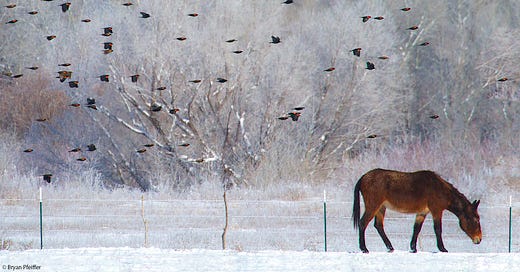NOW MORE THAN EVER, especially as I try to stop the world from spinning so fast, I find solace among the prosaic. This week’s image features wild things flying, Red-winged Blackbirds, and an indifferent mule after a snowfall in Gila, New Mexico.
These are male blackbirds, showing their diagnostic red-and-yellow epaulets. And yet showtime for those shoulders won’t come until early spring, when males flash their stuff to court and mate with multiple females.
A lone male blackbird on his territory (often a cattail marsh) typically mates with two to five females, occasionally even more. He’ll copulate with and defend his females from male intruders.
Or so he might think.
With all those females and nests to protect, a male on occasion gets negligent or distracted or overwhelmed. So it is not uncommon for another male to sneak into the territory for a stealthy copulation with one or more of the females.
It’s not entirely clear to what extent these “extra-pair copulations” help a female and her offspring. She certainly gets diversified genetics (paternity) among her young. And her additional mate might help feed young and defend the nest from predators. But playing the field could also come with a cost. Females with young fathered by more than one male sometimes get less help from males at the nest (Weatherhead 1994). It’s as if the males know the offspring in a given nest aren’t entirely theirs; so they limit “paternal investment.”
As it turns out, lots of birds forgo monogamy. And the terms of engagement are a bit confusing. So here they are:
Polygamy is the general term for either sex having more than one mate (although among humans, for obvious reasons, it tends to be used for one male and multiple females).
Polygyny means one male and multiple females.
Polyandry means one female and multiple males.
Whatever the terms, like nature itself, when it comes to relationships among redwings and other birds … well, it’s complicated. But then again, all I wanted to do was show you a pretty picture of blackbirds and a mule.
Breaking News (and Even More Gratitude)
In only its first month of publication, Chasing Nature has become “Substack Bestseller” (which seems to be unusual among eco writing on this platform). We’ve already cracked the top 20 paid sites in Substack’s “Climate & Environment” category. So I think we’re onto something. Thanks for being here. And please tell your friends about Chasing Nature.
Coming Soon: Online Seminars for Paying Subscribers
By way gratitude, I’m developing a pre-recorded lecture series for paying subscribers to Chasing Nature. Now and then, I’ll cover bird, insect and plant identification and appreciation, as well as nature photography for anyone with an ordinary point-and-shoot camera. A week or so after I post a particular lecture, I’ll run a Substack text chat for questions. Founding subscribers will get live video meets with me on a variety of topics. So if you’re not yet a paying subscriber, please consider an upgrade. Thanks!
Refrences
Weatherhead, P. J., R. Montgomerie, H. L. Gibbs, and P. T. Boag (1994). The cost of extra-pair fertilizations to female red-winged blackbirds. Proceedings of the Royal Society B 258:315-320.
Yasukawa, K. and W. A. Searcy (2020). Red-winged Blackbird (Agelaius phoeniceus), version 1.0. In Birds of the World (P. G. Rodewald, Editor). Cornell Lab of Ornithology, Ithaca, NY, USA. https://doi.org/10.2173/bow.rewbla.01





Stunning photo! Gila NM is a magical place.
I’m looking forward to the photo and P&S camera advice. Carol
Beautiful slice of nature! I've always heard about blackbirds and their multi-nesting habits, so it was great to have some facts about that.
Ever think about doing classes on essay writing? Looking forward to more posts!